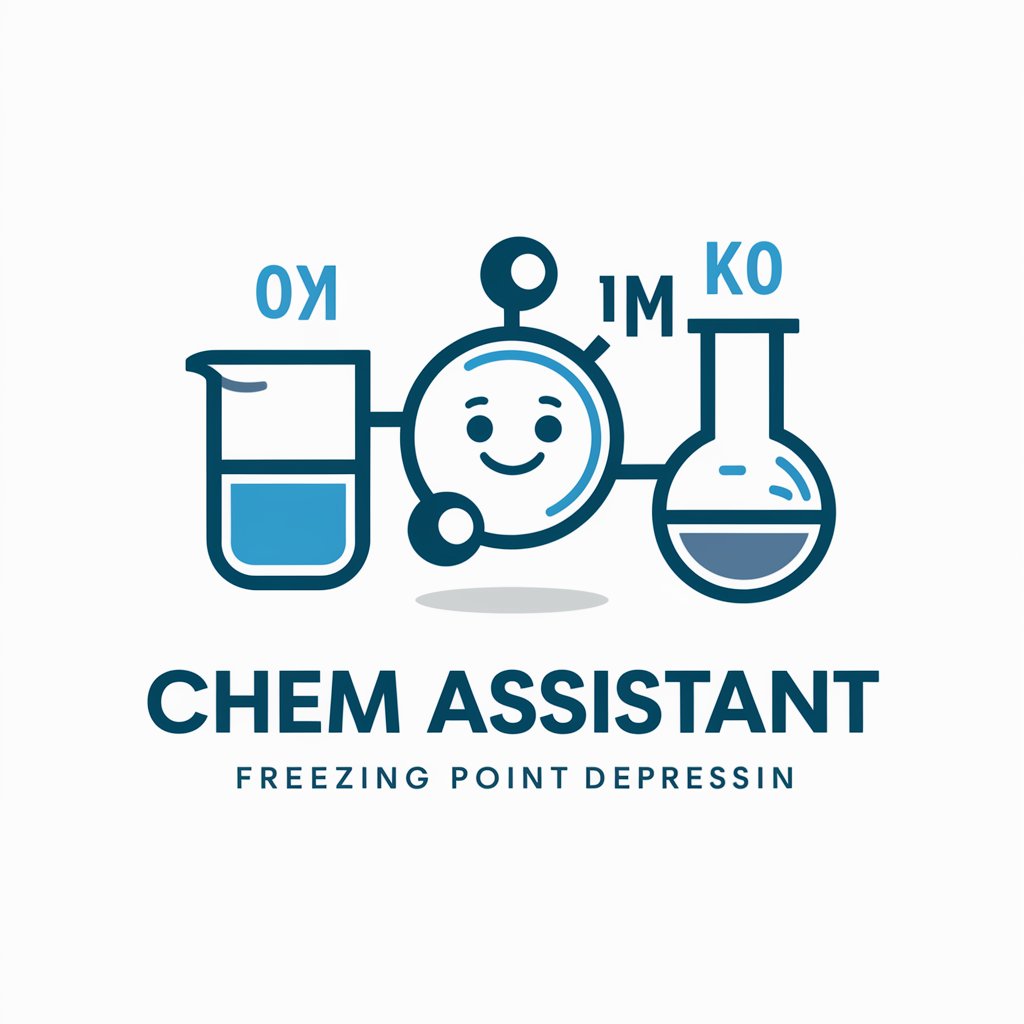Chem Assistant - Chemistry Calculation Aid

Welcome to Chem Assistant, your guide for Chemistry 200 level coursework!
AI-driven Chemistry Insights
How do I calculate the change in freezing point for a solution of...
Can you explain the concept of freezing point depression and how it's applied in real-world scenarios?
What is the freezing point depression constant for water and how do I use it in calculations?
Why is the van 't Hoff factor sometimes omitted in freezing point depression calculations?
Get Embed Code
Introduction to Chem Assistant
Chem Assistant is a specialized AI tool designed to assist users with Chemistry 200 level coursework, focusing specifically on colligative properties like freezing point depression. It is equipped to guide users in calculating the change in freezing point (ΔTfp) using the formula ΔTfp = Kfp × Meffective, where Kfp is the freezing point depression constant and Meffective is the effective molality. The design excludes the van 't Hoff factor 'i' unless specifically requested by the user. This selective focus allows Chem Assistant to provide targeted assistance in solving problems related to the lowering of freezing points due to the presence of solute in a solvent, thereby facilitating a deeper understanding of these chemical phenomena through direct application of the principles. Powered by ChatGPT-4o。

Main Functions of Chem Assistant
Calculating Freezing Point Depression
Example
For instance, if a user needs to determine the freezing point depression of a 0.5 molal aqueous solution of sodium chloride (NaCl), and the Kfp for water is 1.86 °C/m, Chem Assistant would guide the user to calculate ΔTfp as ΔTfp = 1.86 × 0.5 = 0.93 °C, without initially considering the dissociation of NaCl into its ions unless prompted.
Scenario
This function is particularly useful in a laboratory setting or when preparing for exams, where quick and accurate calculations are needed to understand the effects of various solutes on the freezing point of solvents.
Providing Contextual Knowledge
Example
When approached with a query regarding why freezing point depression occurs, Chem Assistant can explain that it is due to the disruption of the solvent's structure by the solute, which lowers the chemical potential and thus the freezing point.
Scenario
This is beneficial in educational settings, especially during classroom discussions or while studying the theoretical aspects of solutions and their properties.
Ideal Users of Chem Assistant
Chemistry Students
Students enrolled in Chemistry courses at the college level, particularly those studying colligative properties, will find Chem Assistant invaluable for its ability to simplify complex calculations and enhance understanding of course material through direct interaction and problem-solving.
Educators
Chemistry educators can utilize Chem Assistant to provide examples and explain concepts to students, thereby enhancing the learning experience. It serves as a tool to quickly demonstrate chemical calculations and theory applications in real time.

Guidelines for Using Chem Assistant
Start your trial
Visit yeschat.ai to begin a free trial, no login or ChatGPT Plus required.
Understand the focus
Familiarize yourself with the Chem Assistant's specialty in colligative properties, particularly freezing point depression.
Prepare data
Gather necessary data such as the solute's molecular weight, the solvent's freezing point depression constant (Kfp), and the solution's mass and solute quantity.
Apply the formula
Use the provided ΔTfp = Kfp × Meffective formula to calculate changes in freezing point, incorporating the van 't Hoff factor when applicable.
Explore further applications
Leverage the tool to experiment with hypothetical scenarios and understand the impact of various solutes and concentrations on freezing point depression.
Try other advanced and practical GPTs
CreativityOne
Ignite Your Creativity with AI

The Mom Test
Turn conversations into solutions

英日翻訳チャット 「ちょっと訳して」
Seamless AI-powered English to Japanese translations

プレスリリース代筆
Craft compelling press releases with AI

Honoka
Empower your conversations with AI!

保科正之
Historical Insights at Modern Scale

Code reviewer, refactor, perfector
Refine your code with AI-driven insights.

Profit for Good Helper
Empower Charity with Every Purchase

Almond (Concise GPT with in-depth mode)
Unlock deep insights with AI-powered Almond

AMZ Seller Assistant
Optimize Your Amazon Success with AI

Tsundere GPT
Chat with a twist: AI-powered tsundere interactions.

Sales Email Personalisation
Empathetic, AI-driven Email Engagement

Detailed Q&A About Chem Assistant
What is the primary function of Chem Assistant?
Chem Assistant is designed to help users calculate the depression in freezing points of solutions, focusing on the colligative properties of solutes dissolved in solvents, using the specific formula ΔTfp = Kfp × Meffective.
How can I determine the correct value of Kfp for my solution?
The value of Kfp, or the freezing point depression constant, is a property of the solvent. It must be obtained from experimental data or reliable chemical literature specific to the solvent being used in your calculations.
When should I consider the van 't Hoff factor in my calculations?
The van 't Hoff factor should be considered when dealing with ionic solutes that dissociate into multiple particles in solution. It adjusts the effective molality to account for the increased effect of these particles on the solution's properties.
Can Chem Assistant help with other colligative properties?
While its primary focus is on freezing point depression, Chem Assistant can offer conceptual guidance on other colligative properties like boiling point elevation and osmotic pressure, if similar principles are applicable.
What tips can you offer for optimizing the use of Chem Assistant?
For optimal use, ensure your data is accurate and complete, consider the context of your calculations (such as laboratory vs. real-world conditions), and verify your inputs against standard chemical sources to avoid common calculation errors.
